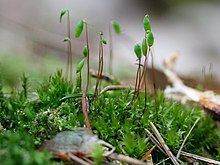Pohlia nutans: Difference between revisions
Appearance
Content deleted Content added
No edit summary |
No edit summary |
||
| Line 87: | Line 87: | ||
}}}} |
}}}} |
||
'''''Pohlia nutans''''', the '''nodding thread-moss''', is a species of [[moss]] in the family [[Mniaceae]].<ref>{{cite web |url=https://bryology.uconn.edu/classification |title=Classification of extant moss genera |last1=Goffinet |first1=B. |last2=Buck |first2=W. R. |date=31 March 2020 |website=bryology.uconn.edu |publisher=University of Connecticut |access-date=1 January 2022 }}</ref> It has a cosmopolitan distribution, found on all seven continents; Europe, Iceland, Siberia, Japan, North America, Greenland, the Andes of South America, South Africa, Tasmania and nearby mainland Australia, New Zealand, and the [[Antarctic Peninsula]] and [[Mount Rittmann]] in Antarctica.<ref name="GBIF_5282610" >{{cite web |title=''Pohlia nutans'' Lindberg, 1879 |url=https://www.gbif.org/species/5282610 |website=gbif.org |publisher=GBIF Secretariat |author=GBIF Backbone Taxonomy. |access-date=1 January 2022 }}</ref> |
'''''Pohlia nutans''''', the '''nodding thread-moss''', is a species of [[moss]] in the family [[Mniaceae]].<ref>{{cite web |url=https://bryology.uconn.edu/classification |title=Classification of extant moss genera |last1=Goffinet |first1=B. |last2=Buck |first2=W. R. |date=31 March 2020 |website=bryology.uconn.edu |publisher=University of Connecticut |access-date=1 January 2022 }}</ref> It has a cosmopolitan distribution, found on all seven continents; Europe, Iceland, Siberia, Japan, North America, Greenland, the Andes of South America, South Africa, Tasmania and nearby mainland Australia, New Zealand, and the [[Antarctic Peninsula]] and [[Mount Rittmann]] in Antarctica.<ref name="GBIF_5282610" >{{cite web |title=''Pohlia nutans'' Lindberg, 1879 |url=https://www.gbif.org/species/5282610 |website=gbif.org |publisher=GBIF Secretariat |author=GBIF Backbone Taxonomy. |access-date=1 January 2022 }}</ref> An extremophile, it is resistant to cold, drought, salt, acid, heavy metals, and intense UV radiation.<ref>{{cite journal |title=Abiotic stress signalling in extremophile land plants |year=2020 |last1=Boulc'h |first1=Pierre-Nicolas |last2=Caullireau |first2=Emma |last3=Faucher |first3=Elvina |last4=Gouerou |first4=Maverick |last5=Guérin |first5=Amandine |last6=Miray |first6=Romane |last7=Couée |first7=Ivan |journal=Journal of Experimental Botany |volume=71 |issue=19 |pages=5771–5785 |doi=10.1093/jxb/eraa336 |pmid=32687568 }}</ref><ref>{{cite journal |title=PnSAG1, an E3 ubiquitin ligase of the Antarctic moss ''Pohlia nutans'', enhanced sensitivity to salt stress and ABA |year=2019 |last1=Wang |first1=Jing |last2=Liu |first2=Shenghao |last3=Liu |first3=Hongwei |last4=Chen |first4=Kaoshan |last5=Zhang |first5=Pengying |journal=Plant Physiology and Biochemistry |volume=141 |pages=343–352 |doi=10.1016/j.plaphy.2019.06.002 |pmid=31207495 |s2cid=190533214 }}</ref><ref>{{cite journal |title=Native plants facilitate vegetation succession on amended and unamended mine tailings |year=2021 |last1=Munford |first1=Kimber E. |last2=Asemaninejad |first2=Asma |last3=Basiliko |first3=Nathan |last4=Mykytczuk |first4=Nadia C. S. |last5=Glasauer |first5=Susan |last6=McGarry |first6=Samantha |last7=Watmough |first7=Shaun A. |journal=International Journal of Phytoremediation |pages=1–12 |doi=10.1080/15226514.2021.1987382 |pmid=34647850 |s2cid=238858978 }}</ref><ref>{{cite journal |title=Transcriptional profiling and physiological analysis reveal the critical roles of ROS-scavenging system in the Antarctic moss Pohlia nutans under Ultraviolet-B radiation |year=2019 |last1=Li |first1=Chengcheng |last2=Liu |first2=Shenghao |last3=Zhang |first3=Wei |last4=Chen |first4=Kaoshan |last5=Zhang |first5=Pengying |journal=Plant Physiology and Biochemistry |volume=134 |pages=113–122 |doi=10.1016/j.plaphy.2018.10.034 |pmid=30448024 |s2cid=53947267 }}</ref> |
||
==Subtaxa== |
==Subtaxa== |
||
Revision as of 09:44, 1 January 2022
| Pohlia nutans | |
|---|---|

| |
| Scientific classification | |
| Kingdom: | Plantae |
| Division: | Bryophyta |
| Class: | Bryopsida |
| Subclass: | Bryidae |
| Order: | Bryales |
| Family: | Mniaceae |
| Genus: | Pohlia |
| Species: | P. nutans
|
| Binomial name | |
| Pohlia nutans | |
| Synonyms[1] | |
|
List
| |
Pohlia nutans, the nodding thread-moss, is a species of moss in the family Mniaceae.[2] It has a cosmopolitan distribution, found on all seven continents; Europe, Iceland, Siberia, Japan, North America, Greenland, the Andes of South America, South Africa, Tasmania and nearby mainland Australia, New Zealand, and the Antarctic Peninsula and Mount Rittmann in Antarctica.[1] An extremophile, it is resistant to cold, drought, salt, acid, heavy metals, and intense UV radiation.[3][4][5][6]
Subtaxa
The following subtaxa are accepted:[1]
- Pohlia nutans subsp. nutans (Hedw.) Lindb.
- Pohlia nutans subsp. otaruensis (Cardot) Ochi
- Pohlia nutans subsp. schimperi (Müll.Hal.) Nyholm
- Pohlia nutans f. angustiretis (H.Winter ex Broth.) Podp.
- Pohlia nutans f. arenaria (Mikut.) Podp.
- Pohlia nutans f. brevicuspidata (Roll) Podp.
- Pohlia nutans f. bryoides (Schiffner) Podp.
- Pohlia nutans f. compacta (Roll) Podp.
- Pohlia nutans f. cuspidatulum (Kindb.) Podp.
- Pohlia nutans f. decurtata (Warnst.) Podp.
- Pohlia nutans f. flagellata (Roll) Podp.
- Pohlia nutans f. gemmiclada (Schiffner) Podp.
- Pohlia nutans f. inclinata (Podp.) Podp.
- Pohlia nutans f. laxa (H.Winter) Podp.
- Pohlia nutans f. longicuspidata (Roll) Podp.
- Pohlia nutans f. microspora (Latzel) Podp.
- Pohlia nutans f. mollis (Warnst.) Podp.
- Pohlia nutans f. nutans
- Pohlia nutans f. patula (Loeske) E.Bauer
- Pohlia nutans f. pehrii (Latzel) Podp.
- Pohlia nutans f. prolifera (Warnst.) Podp.
- Pohlia nutans f. pseudocucullata (Limpr.) Podp.
- Pohlia nutans f. purpurascens (Latzel) Podp.
- Pohlia nutans f. ramosissima (Hamm.) Podp.
- Pohlia nutans f. robusta (Boulay) Podp.
- Pohlia nutans f. saltans (Loeske) Podp.
- Pohlia nutans f. stollei (Riehm.) Podp.
- Pohlia nutans f. teres (C.E.O.Jensen) Podp.
References
- ^ a b c GBIF Backbone Taxonomy. "Pohlia nutans Lindberg, 1879". gbif.org. GBIF Secretariat. Retrieved 1 January 2022.
- ^ Goffinet, B.; Buck, W. R. (31 March 2020). "Classification of extant moss genera". bryology.uconn.edu. University of Connecticut. Retrieved 1 January 2022.
- ^ Boulc'h, Pierre-Nicolas; Caullireau, Emma; Faucher, Elvina; Gouerou, Maverick; Guérin, Amandine; Miray, Romane; Couée, Ivan (2020). "Abiotic stress signalling in extremophile land plants". Journal of Experimental Botany. 71 (19): 5771–5785. doi:10.1093/jxb/eraa336. PMID 32687568.
- ^ Wang, Jing; Liu, Shenghao; Liu, Hongwei; Chen, Kaoshan; Zhang, Pengying (2019). "PnSAG1, an E3 ubiquitin ligase of the Antarctic moss Pohlia nutans, enhanced sensitivity to salt stress and ABA". Plant Physiology and Biochemistry. 141: 343–352. doi:10.1016/j.plaphy.2019.06.002. PMID 31207495. S2CID 190533214.
- ^ Munford, Kimber E.; Asemaninejad, Asma; Basiliko, Nathan; Mykytczuk, Nadia C. S.; Glasauer, Susan; McGarry, Samantha; Watmough, Shaun A. (2021). "Native plants facilitate vegetation succession on amended and unamended mine tailings". International Journal of Phytoremediation: 1–12. doi:10.1080/15226514.2021.1987382. PMID 34647850. S2CID 238858978.
- ^ Li, Chengcheng; Liu, Shenghao; Zhang, Wei; Chen, Kaoshan; Zhang, Pengying (2019). "Transcriptional profiling and physiological analysis reveal the critical roles of ROS-scavenging system in the Antarctic moss Pohlia nutans under Ultraviolet-B radiation". Plant Physiology and Biochemistry. 134: 113–122. doi:10.1016/j.plaphy.2018.10.034. PMID 30448024. S2CID 53947267.
